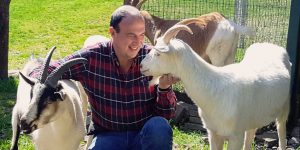Something Borrowed, Something True: 8 of My Favorite Sayings
 There are plenty of maxims, adages, and popular sayings in the training community. I tend to avoid them, because they can be simplistic, overused, or embraced too fiercely by some trainers. In reviewing my classes at The Ranch and my various seminars, however, I discovered that there are a few sayings that I do share with my students regularly. It made me wonder why these statements have stuck with me over the years, and I thought I’d share why I find them so helpful when I teach. I don’t usually quote the saying verbatim, but I always give credit to the trainer who made the concept resonate for me. Here are some of my favorites:
There are plenty of maxims, adages, and popular sayings in the training community. I tend to avoid them, because they can be simplistic, overused, or embraced too fiercely by some trainers. In reviewing my classes at The Ranch and my various seminars, however, I discovered that there are a few sayings that I do share with my students regularly. It made me wonder why these statements have stuck with me over the years, and I thought I’d share why I find them so helpful when I teach. I don’t usually quote the saying verbatim, but I always give credit to the trainer who made the concept resonate for me. Here are some of my favorites:
1. “I’d like to share my biases” —Kathy Sdao
I heard Kathy make this statement in the introduction of one of the first lectures I saw her present. She explained that while she tries her best to be objective and factual, she recognizes that she brings biases from her own experiences and background to the podium when she lectures. She then described those biases. I now use a similar approach, because I think it is helpful for the listener to know that I can’t help but look at a topic through the filter of my own experiences. By sharing my training background and philosophy at the beginning of a lecture, I help my students better understand my point of view.
2. “Training is a mechanical skill” —Bob Bailey
I used to bristle at this statement because I felt that it diminished the importance of the skills we develop as trainers. As I gained experience and began teaching young trainers myself, though, I’ve learned the value of that statement. So much of good training comes from precise clicker use, treat delivery, and observational skills. When these skills are practiced regularly, with care and accuracy, they become automatic and allow trainers to focus on other aspects of the behavior being trained.
I equate the initial-skills acquisition to how I felt when I first learned to drive a car; at first, I had to really focus to stay in my lane and to respond quickly to brake lights in front of me, but with experience these mechanical skills became second nature and allowed me to concentrate on other aspects of driving, such as navigating. Today, I spend a great deal of time on mechanical skills with new trainers and appreciate the wisdom of Bob’s statement.
"So much of good training comes from precise clicker use, treat delivery, and observational skills."
3. “The animals are the easy part” —Bob Bailey
I hear people quote this saying all the time, joking about how difficult clients can be. While I agree that the “people part” is often more difficult than the “animal part,” both are crucial for the success of training, and both involve similar training abilities. I prefer not to dwell on “what’s wrong with our clients,” but rather explore how to get the client to a level of proficiency and understanding necessary for success. Some of the best trainers I know fail as consultants because of their lack of people skills; I believe it is important for our community to make the use of positive reinforcement with people a priority when we teach people how to train.
4. “Unlabel me” —Susan G. Friedman, Ph.D.
Susan encourages us to be careful with the labels that we put on animals: he’s phobic, she’s frustrated, he’s temperamental. This idea goes to the heart of what we should be doing as trainers when we problem-solve. Too often we put a label on a behavior and assume that it explains the behavior or the cause of a problem. Susan’s saying reminds us to go further than simply calling an animal “aggressive,” for example, and instead describe what the behavior looks like. Is there data about the frequency, context, consequences, and other factors that can help train more effectively? It’s OK to use terms such as “aggressive” or “playful” as long as we remember that they are just convenient labels. The behavior and its context must be described clearly if we hope to be successful at changing that behavior.
"The behavior and its context must be described clearly if we hope to be successful at changing that behavior"
5. “The only thing two trainers can agree on is what a third trainer is doing wrong” —Steve White
When Steve uses this line, he always gets a laugh. The humor lies in the truth behind the statement. As a community of trainers, we can be very opinionated and critical of one another. I see this saying as a call to action: we need to be more open-minded and welcoming of trainers who train differently. Our training communities are becoming more and more closed-minded and less accepting of outside thoughts. We will be more successful spreading our positive reinforcement strategies and ultimately help the animals we care for if we approach each other with kindness and understanding and use positive reinforcement with one another.
6. “It's just behavior” —Karen Pryor
I have seen Karen reassure skilled trainers who are dealing with complex behavior problems by saying, “It’s just behavior, and you know how to shape behavior!” In these instances, Karen was not trying to minimize the seriousness of the behavioral problem. She was reminding trainers that no matter how challenging an issue, returning to the basics will help find solutions to the most difficult behavioral situations. I think of this statement every time I take on a complex consulting job that concerns me; I remind myself to look at the environment (antecedent arrangements and consequences) and break the problem into its smallest component parts. When I remember that it’s just behavior, suddenly the problem doesn’t seem quite as overwhelming!
"When I remember that it’s just behavior, suddenly the problem doesn’t seem quite as overwhelming!"
7. “The rat is always right” —B.F. Skinner
This famous phrase by B.F. Skinner and its derivatives, “the animal is always right,” “the dog is never wrong,” and so on remind us that animals behave the way they do based on past experiences in particular contexts. If you want to change an animal’s behavior, you need to change what you are doing. Trainers must accept responsibility for getting desired behavior from animals. There is a corollary idea in scent-detection work that says, “trust your dog.” Once you are in the field, if you have trained the dog well, if the dog indicates that he has found something, believe him!
8. “Training is not a luxury” —Ken Ramirez
Please indulge me while I share one of my own sayings, which I use in every class and seminar that I teach: training should not be considered a luxury but should be a key component of any good animal-care program. Behavior management, which includes training and enrichment, ought to be a cornerstone of good animal care alongside veterinary care, nutrition, a proper environment, and appropriate social structure. In many animal-care programs, training is an afterthought, something to do if there is time. Elevating the importance of training in the minds of the public and in the minds of animal-care professionals is one of my ongoing life missions.
"Training should not be considered a luxury but should be a key component of any good animal-care program."
I am sure there are other sayings that I use from time to time, but these are the most relevant and useful to my teaching. I am grateful to the many trainers who continue to be my teachers and provide valuable mental models.
Happy Training, Ken
 Ken Ramirez is the Executive Vice President and Chief Training Officer at Karen Pryor Clicker Training (KPCT). A trainer and consultant for 40+ years, Ken most recently served as the Executive Vice President, Animal Care and Training, at Chicago’s world-famous Shedd Aquarium. He is the author of several books and DVDs, including ANIMAL TRAINING: Successful Animal Management Through Positive Reinforcement, which has become required reading for many trainers in the zoological field. Learn more about Ken Ramirez.
Ken Ramirez is the Executive Vice President and Chief Training Officer at Karen Pryor Clicker Training (KPCT). A trainer and consultant for 40+ years, Ken most recently served as the Executive Vice President, Animal Care and Training, at Chicago’s world-famous Shedd Aquarium. He is the author of several books and DVDs, including ANIMAL TRAINING: Successful Animal Management Through Positive Reinforcement, which has become required reading for many trainers in the zoological field. Learn more about Ken Ramirez.


Comments
This is not my quote. It was a quote about me from JENNIFER CRANK -there is no standing still in agility, Mona! -emphasis on the Mona.
Actually I save favorite quotes and handg them on my training room wall.